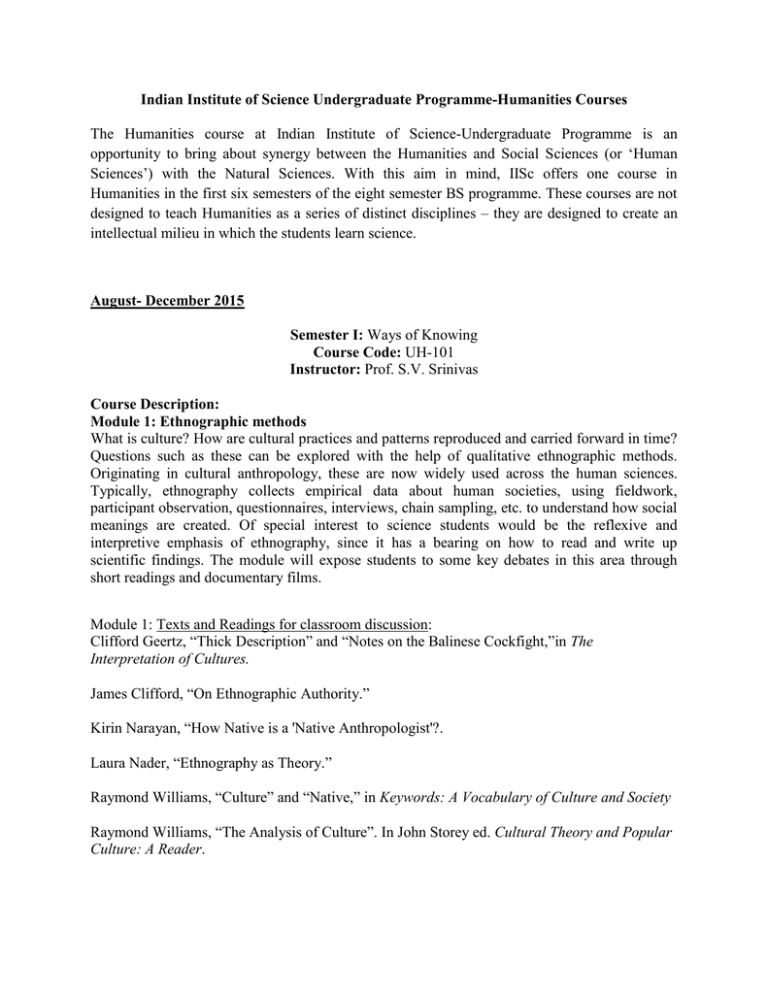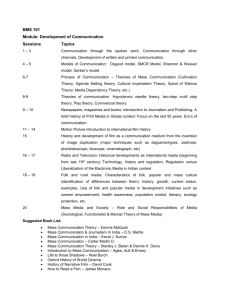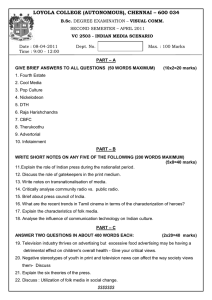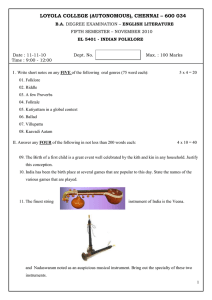Curriculum - Indian Institute of Science
advertisement

Indian Institute of Science Undergraduate Programme-Humanities Courses The Humanities course at Indian Institute of Science-Undergraduate Programme is an opportunity to bring about synergy between the Humanities and Social Sciences (or ‘Human Sciences’) with the Natural Sciences. With this aim in mind, IISc offers one course in Humanities in the first six semesters of the eight semester BS programme. These courses are not designed to teach Humanities as a series of distinct disciplines – they are designed to create an intellectual milieu in which the students learn science. August- December 2015 Semester I: Ways of Knowing Course Code: UH-101 Instructor: Prof. S.V. Srinivas Course Description: Module 1: Ethnographic methods What is culture? How are cultural practices and patterns reproduced and carried forward in time? Questions such as these can be explored with the help of qualitative ethnographic methods. Originating in cultural anthropology, these are now widely used across the human sciences. Typically, ethnography collects empirical data about human societies, using fieldwork, participant observation, questionnaires, interviews, chain sampling, etc. to understand how social meanings are created. Of special interest to science students would be the reflexive and interpretive emphasis of ethnography, since it has a bearing on how to read and write up scientific findings. The module will expose students to some key debates in this area through short readings and documentary films. Module 1: Texts and Readings for classroom discussion: Clifford Geertz, “Thick Description” and “Notes on the Balinese Cockfight,”in The Interpretation of Cultures. James Clifford, “On Ethnographic Authority.” Kirin Narayan, “How Native is a 'Native Anthropologist'?. Laura Nader, “Ethnography as Theory.” Raymond Williams, “Culture” and “Native,” in Keywords: A Vocabulary of Culture and Society Raymond Williams, “The Analysis of Culture”. In John Storey ed. Cultural Theory and Popular Culture: A Reader. Module 2: Historical analysis How do we assemble and examine data from the past? What are the problems we might encounter in verifying the accuracy of this data? Although the discipline of History pioneered archival work in relation to societies with written documents, almost every branch of social sciences and humanities uses methods that in different ways take up and discuss historical examples. This is true of the natural sciences as well. This module will briefly introduce students to historical research and then examine the issues confronting researchers in this field of knowledge production. The focus of the module is on the relationship between the past and present. It encourages students to engage with the problem of how a researcher located in the present might access or reconstruct the past. The module, while discussing these issues, will also touch upon some of the challenges to conventional history-writing. Module 2: Texts and Readings for classroom discussion: E.H. Carr, What is History? Giorgio Agamben, “What is the Contemporary?” in What is Apparatus? And Other Essays . Shahid Amin. “Gandhi as Mahatma: Gorakhpur District, Eastern UP, 1921–22,” in Ranajit Guha, ed., Subaltern Studies III. Lata Mani, “Contentious Traditions: The Debate on Sati in Colonial India,” in Kumkum Sangari and Sudesh Vaid, eds., Recasting Women: Essays in Colonial History. Frigga Haug, “Memory-work as a Method of Social Science Research: A Detailed Rendering of Memory-Work Method,” in Memory Work – A Research Guide. Joan Scott, “The Evidence of Experience.” Module 2: Film screening: 12 Monkeys (Terry Gilliam, 1995) Module 3: Textual analysis: This module introduces student to key concepts and issues in textual analysis, a method adopted by students of literature but also History and other disciplines. It begins with the discussion of what a text is and the relationship of the writer to the text written by him or her. It then goes on to discuss how meaning is produced from a text and who produces it. It then returns to the problem of interpretation, discussed in the earlier modules, to focus on the reader’s role in interpreting texts and generating meaning. examine how texts are What is the role of the reader in interpreting textual meaning? Students will be introduced in this module to methods of close reading drawn from literary criticism and cultural studies. Module 3: Texts and Readings for classroom discussion: Excerpt from: James Jeans, “The Mysterious Universe”in G.H Hardy ed., The Oxford Book of Modern Science Writing. Excerpt from: C.P Snow, Foreword to “ A Mathematician’s Apology” in G.H Hardy, The Oxford Book of Modern Science Writing. Jonathan Culler, “Language, Meaning and Interpretation” Literary Theory: A Very Short Introduction (New York: Oxford University Press) 2000, pp 55 – 68. Peter Childs & Roger Fowler, “Context”, “Intertextuality”, “Author”, “Reader” The Routledge Dictionary of Literary Terms; (New York: Taylor & Francis) 2006. Tony Bennett & Lawrence Grossberg, “Text” New Keywords: A Revised Vocabulary of Culture and Society (Malden: Blackwell Publishing) 2005, pp. 345-347 Alan Mckee, “What is Textual Analysis”, Textual Analysis: A Beginner’s Guide (London: Sage Publications) 2003, pp 1-33 Roland Barthes, “From Work to Text” and “Death of the Author” in Image-Music-Text. Michel Foucault, “What is an Author?” in Paul Rabinow ed., The Foucault Reader. Module 3: Case Study: Ranajit Guha, “The prose of counterinsurgency” in Elementary Aspects of Peasant Insurgency in Colonial India. Humanities Lab: Writing workshop. Conducted by the course instructor, with inputs from visiting lecturers. This workshop will expose students to modes of analytical writing, report writing, etc. Semester III: Ways of Doing: Mapping Science-Society Relationship Course Code: UH-201 Instructors: Anshuman Manur, Sabah Siddiqui, Prof. Rajan Gurukkal, Prof. H.N. Chanakya Course Description: Module 1: The Digital Subject What does a digital subject look like? How do digital technologies produce new interfaces for interaction and mobilisation? How do the new interfaces affect older forms of social and political movements? As globalisation consolidates itself, we see changes in the patterns of governance, of state operation, of citizen engagement and civic action. We are in the midst of major revolutions in the Middle East and North Africa, powered by digital social change, some headed by cyber-utopians specializing in Web 2.0 and social media. Phrases like ‘Twitter Revolutions’ and ‘Facebook Protests’ have become common. How do we develop integrated sciencetechnology-society approaches to understand our technology-mediated contemporary and futures? Readings: Balibar, Etienne. “Citizen-Subject.” Who Comes After the Subject. Eds Eduardo Cadava, Peter Connor and Jean-Luc Nancy. New York: Routledge, 1991. Print. Chatterjee, Partha. “Beyond the Nation, or Within?” EPW 32.1/2. JSTOR. http://www.jstor.org/stable/4404962 ----. “Populations and Political Society.” The Politics of the Governed: Reflections on Popular Politics in Most of the World. New York: CUP, 2004. Print. Clark, Andy. “Introduction.” Natural Born Cyborgs: Minds, Technologies, and the Future of Human Intelligence. Oxford: OUP, 2003. Print David, Anat-Ben. “Digital Natives and the Return of the Local Cause.” Digital AlterNatives with a Cause?. Ed. Nishant Shah and Fieke Jensen. Bangalore: CIS, 2011. Haraway, Donna. “A Cyborg Manifesto: Science, Technology, and Socialist-Feminism in the Late Twentieth Century.” Simians, Cyborgs, and Women: The Reinvention of Nature. New York: Routledge, 1991. Print. Rajadhyaksha, Ashish. “Chapter One: Naming the Problem: Or, Thinking Like the State.” The Last Cultural Mile: An Inquiry into Technology and Governance in India. CIS. http://cis-india.org/raw/histories-of-the-internet/last-cultural-mile.pdf ----. “Digital Delivery of Services: The Indian Landscape.” IN The Wake of Aadhaar: The Digital Ecosystem of Governance in India. Bangalore: CSCS, 2013. E-book. Shah, Nishant. “Subject to Technology: Internet Pornography, Cyber-Terrorism and the Indian State.” Inter-Asia Cultural Studies 8.3 (349-366). http://dx.doi.org/10.1080/14649370701393725 Module 2: Brain-Mind Divide This module looks at contemporary debates in Cognitive Studies to show how we might require an interdisciplinary perspective, integrating insights from neurobiology, evolutionary history, biophysics, computation, cultural studies, psychology and civilizational histories, to make sense of "what makes us think". Natural sciences talk about the brain and humanities disciplines talk about the mind. Is the object of inquiry actually one and the same, and would it be better analysed through an inter-disciplinary approach? Readings: Miller, G. A. (2003). The cognitive revolution: a historical perspective. Trends in Cognitive Sciences, Vol.7, No.3, March 2003. Ramachandran, V. S. (2011). The tell-tale brain. New York: W. W. Norton. Chapters: Introduction - No Mere Ape Chapter 1 - Phantom Limbs and Plastic Brains Chapter 4 - The Neurons that Shaped Civilization Chapter 7 - Beauty and the Brain: The Emergence of Aesthetics Freud, S. (1925). A Note upon the "Mystic Writing Pad". Turnbull, O. and Solms, M. (2003). The Brain and the Inner World: An Introduction to the Neuroscience of Subjective Experience. New York: Other Press Book. Chapter 6 - Dreams and Hallucinations Module 3: People and Nature This module will approach the theme of people and nature from several natural science, social science, humanities and arts perspectives. The course will discuss the evolution of our conception of nature, our understanding of our place in nature, our understanding of how nature works and our attempts to describe, appreciate, control and manipulate nature. This module will be more multidisciplinary than interdisciplinary and will attempt to showcase the significant variation across, disciplines, historical time and geographical space, in our approach to nature, and the inevitable conflicts such variation generates. Readings: Alfred W. Crosby, Ecological Imperialism: The Biological Expansion of Europe, 9001900, Cambridge University Press, 2004 Clive Ponting, A New Green History of the World: The Environment and the Collapse of Great Civilizations, Penguin Books, rev.ed. 2007 Gilbert F. LaFreniere, The Decline of Nature: Environmental History and the Western Worldview, Paper Back ed. Oak Savanna Publishing, Corvallis, Oregon, 2012 Donella H. Meadows, Jorgen Randers, Dennis L. Meadows, The Limits to Growth: The 30-Year Update, Chelsea Green Pub., Vermont, 2004 Emilio F. Moran, People and Nature: An Introduction to Human Ecological Relations, Wiley-Blackwell, 2006 Module 4: Sustainable Development This module will approach the gradually evolving concepts of sustainable development from the Indian to a Global perspective and in the process bring about the various societal forces (local and global) that evolve(d) the meanings of sustainability and sustainable development, emerging debates and likely conflicts into the future. Is sustainability Science? Examining how people of natural, engineering and social sciences perceive sustainability in different perspectives /domains and the potential to integrate these perspectives for completeness, S&T in championing sustainable development. Measuring sustainability and evolving indices for sustainability. Lab Work: Writing workshop and/or presenting case studies of Technologies and sustainable development (as in Semester 1, but at a more advanced level). Semester V: Journalism for Scientists Course Code: UH-301 Instructor: Amrita Shah Course Description: The Course will be useful in acquainting students with journalistic skills which they may apply in their own work to observe and communicate better for instance or to their field as future science reporters, perhaps or as individuals who might have to explain science to the lay person. It also seeks to provoke thought on the practice of journalism, its tenets, its limitations and its influence with a view to encouraging a more critical engagement with media but also to position science within the media. Class 1: What is News? The media shapes society’s perception of what is newsworthy. How does one identify an event as news? Class 2: Reporting News gathering methods; an analysis of samples of reportage. Class 3: How to investigate Innovative or extraordinary methods used in journalism to uncover truths not available by conventional means. Class 4: New Media Print, television, video, satellite TV and the small screen of the cell phone. A discussion on how technological advance affects journalism. Class 5: Reporting Science How is science reported in the mainstream media? Is the coverage adequate and informed? Class 6: Science Journalism Trends and approaches in Indian and international science magazines. Class 7: How to research and write an article for a newspaper or magazine Practical tips and guidelines Class 8: Expressing an opinion Constructing and presenting a point of view as in a column or a review Class 9: The Art of the Interview Practical tips and guidelines on conducting interviews Class 10: Ethics and Dilemmas The media is both a public service and a business. What are the conflicts and compromises that journalists face? Class 11: Preparing to write a book Early steps in turning an idea into a book : laying the ground and writing a proposal. Class 12: Class Discussion possibly with Guest Speaker on dealing with the newsroom Class 13: Class Exercise in reading news/anchoring media debates and so on Class 14: Concluding Discussion Elaborating points of interest raised in earlier classes and answering queries Readings: Sainath, P. “The Trickle Up Down Theory; Or, health for the millions.” In Everybody Loves a Good Drought, (New Delhi: Penguin Books), 2000, pp.23-27. Verghese, B G. “The Making of a Marwari Tamil”. In Warrior of the fourth estate : Ramnath Goenka of the Express, (New Delhi : Viking), 2005, pp.24-30. Morris, James. “The Conquest of Everest, 29 May 1953”. In John Carey. The Faber Book of Reportage, (Faber & Faber), 1996, pp.660-662. Wenner, Jann. “Bruce Springsteen”. In Jann Wenner & Joe Levy. The Rolling Stone Interviews (New York : Back Bay Books), 2008, pp.13-19. Wolfe, Tom. “Selections”. In The new journalism, (E W Johnson; Picador), 1990, pp.4042. Mehta, Vinod. “Introduction”. In Lucknow boy : a memoir, (New Delhi : Penguin Viking), 2011, pp.vii-xxi. Hype, Hypocrisy & Television in Urban India (Vikas, New Delhi 1997) by Amrita Shah Vikram Sarabhai-A Life (Viking-Penguin, 2007) by Amrita Shah January- April 2016 Semester II: Ways of Seeing Course Code: UH-102 Instructor: Prof. S.V. Srinivas Course Description: Semester 2: Ways of Seeing This course introduces students to a) the ways in which cultural forms and genres represent the world around us and b) how we see and understand the world as refracted by these forms. There will be three modules. In short, this is a course about seeing and interpreting the forms that show us the world. Each module discusses a particular cultural form and also focuses on one theme. General introduction (3 sessions): Reinforcement of concepts and theories introduced in Semester I: archive, text, author, reader, and interpretation. Theory texts used by instructor: Roland Barthes, Image-Music-Text and Raymond Williams, Keywords. Module 1 (8 sessions): Literature: What do we need to know in order to appreciate creative writing? How do we read and interpret literary works? Where does meaning lie? How do we ‘learn’ from literature? Special focus on science fiction: good science and bad science; space/distance and time/history; human and non-human; science & technology and nature. Readings circulated to students: Issac Asimov, Selections from I, Robot: “Introduction,” “Robbie,” “Runaround” and “Reason” Satyajit Ray, “Diary of a Space Traveller” and “Bonku Babu’s Friend” Vandana Singh, Selections from The woman who thought she was a Planet: “Woman who thought she was a planet,” “Hunger” and “Tetrahedron.” Module 2 (8 sessions): Visual Arts: How do paintings represent reality? Is realism more “scientific” than other ways of presenting the world? How does technology determine the evolution of art forms? What problems did artists face in the Indian context as they adopted western styles and forms? Special focus on mythology and its representation in modern Indian art. Text used by Instructor: John Berger, Ways of Seeing Readings circulated to students: Gulammohammed Sheik, “Mobile Vision: Some Synoptic Comments” Walter Benjamin: “Work of art in the age of mechanical reproduction.” Module 3 (8 sessions): Film: History of cinema as a technological form, technophobic reactions to film. Audiences and spectatorship. Film as an urban, democratic form. How fiction and nonfiction films “document” reality and what they can they tell us about society; how to “read” films. Special focus on the city, as subject of cinema and site of film production and viewing. Texts used by instructor: Ashish Rajadhyaksha, “Phalke Era: The Conflict of Traditional Form and Modern Technology” and Walter Benjamin, Selections from The Arcades Project. Readings circulated: Ranjani Mazumdar, “The Panaromic Interior” from Bombay Cinema: An Archive of the City. Films: DG Phalke, Shri Krishna Janma (1918); Fritz Lang, Metropolis (1927) and Dziga Vertov, Man with a Moving Camera (1929). Conclusion (1 session) Projects and Assessment: Module 1. Literature (Science-Fiction): Write a science fiction narrative highlighting the issues that came during this module. Namely, a) human and non-human relationship; b) space and time c) science & technology and nature and d) good science and bad science OR Prepare a teaching module for pre-university students or arts undergraduates using science fiction works (films, novels or short stories) to introduce concepts in science of your choice. Marks for the project (mid-term assessment): 40 marks Module 2: Visual art: Class test: 10 marks Module 3. Film (focus on the city): Students can choose between Option A and B Option A: Make an original film to document your city or life in your city. You are free to narrate a story or make a documentary film but highlight what you think are the most characteristic or unique features of your city. Duration: For projects that are being submitted by groups, the duration is 5 minutes (minimum) to 15 minutes (maximum). For submissions by individuals, the duration is 3 minutes (minimum) to 10 minutes (maximum). OR Option B: Make a compilation of film clips to comment on or critique representations of cities in documentaries or feature films made by others. Ensure that your commentary focuses on how cities are shown in the films you have chosen. Duration: 10 minutes (minimum) Mandatory requirement: projects have to be related to the course i.e., how are cities shown in film? what are the connections between cinema and the city? [A professional editor was invited to class to introduce students to the basics of video editing before they began working on their projects]. Marks for the project (end-semester assessment): 50 marks. Semester IV: Mapping India through the Folk Arts Course Code: UH-203 Instructor: Dr. Bitasta Das Course Description: The objective of this course is to understand the seven regions of India—North, West, East South, Central, North-East and the Islands a little better—through their folk arts. The course considers the art forms, as viewed in the discipline of Folkloristics, as means of knowing the regional cultures from “inside-out rather than outside-in”. The aim of this seminar course is to provide the students a broad idea of India as a “nation”, its diverse regional specificities and the relevance of the folk arts in understanding the “national” and the “regional”. The students will get an oppourtunity to interact with folk artists and gain first-hand knowledge about various aspects of the folk arts to understand the synergy between artistic worldview and the contemporary social milieu. The course will be useful in recognizing how meaning is produced and expressed in folk domain and at the same time, aid the students to gain cognizance of Indian multiculturalism. Class Plan Class 1: Nation and the Folk: In the introduction class the relationship between a nation and its folk arts will be explored. Focusing on India the class will probe into the different art formsclassical, folk, tribal and popular. Class 2: Folk-Philosophy: Here the deeper meaning of folk expressions will be taken on board. An Indian folk philosopher’s work will be discussed. Class 3: Design and Learning to make a folk art: This will be a theoretical class on design followed by a workshop on making a folk art. Class 4: Survival and Renovation: Tracing its history, the changes that folk arts go through over the time for survival and sustenance will be illustrated. Class 5: Copyright and Archiving: In this class the need to protect the folk arts against the threats from globalization will be foregrounded. Class 6: Gender Question: The gender equations within the artists and the relationship with the art will be discussed in this class. Class 7: Folk Arts and the Market Economy: How the market situation affects the folk arts and artists will be elaborated in this class. Class 8: Art Criticism: This class will understand the basics of art criticism. Class 9: Critical Writing: Here the students will engage with and learn few techniques of critical art writing. Class 10: Field trip: Observation of local folk art performance. Readings: Dundes, Alan. Essays in Folkloristics. University of Michigan. 1978. Pattanayak, D.P, Claus, Peter and Handoo, Jawahar lal. Indian Folklore. Volume II. Mysore. Central Institute of Indian Languages. 1981. Pattanayak, D.P and Claus, Peter. Indian Folklore. Volume I. Mysore. Central Institute of Indian Languages. 1981. Dundes, Alan. Interpreting Folklore. Indiana University. 1980. Bronner, Simon J. The Meaning of Folklore: Analytical Essays of Alan Dundes. Logan, Utah. Utah State University Press. 2007. Dorson, M Richard. Folklore and Folklife. Chicago. University of Chicago Press. 1972. Dorson, M Richard. Folklore in the Modern World. Mouton Publishers. 1978. Alexander Haggerty Krappe. Science of Folklore. Kessinger Publishing. 1930. Anderson, Benedict. Imagined Community Reflection On The Origin And The Spread Of Nationalism. New York. Verso. 1991 Bhabha, Homi. K (ed.). Nation and Narration. New York. Routledge. 1990. Handoo, Jawahar lal. Folklore an Introduction. Mysore. Central Institute of Indian Languages. 1989. Semester VI: Introduction to Governance Course Code: UH-302 Instructor: Dr. Uday Balakrishnan Course Description: The Semester long programme on Introduction to Governance is to enable the participants to develop an appreciation of key issues and challenges to governance in India while gaining an insight into how the Government of India works and relates to the people. The Semester- long programme will be largely interactive and to facilitate this (i) Select reading material will be given ahead of each session (a) additionally a selection of books will be available for consultation in the library of the Centre for Contemporary Studies –IISc. Some if not all of the sessions are expected to be supplemented by experts drawn from the top echelons of public administration, the judiciary and politics. Evaluation is based on group projects and individual assignments emerging from each covering a range of contemporary issues that engage us as concerned citizens of our country. Class Plan Class 1: Introduction to the Semester and assignment of group projects Class 2: The challenge of good governance in a democracy followed by presentation of group project (1) People Power as driver of change in Governance Class 3: Overview of the Indian Constitution followed by group project (2) Examining the 42nd Amendment to the Indian Constitution- Was it necessary? Class 4: How the Indian Parliament works followed by group project (3) Evaluating the 15th latest following the 2009 elections- Lok Sabha. Class 5: Understanding Indian bureaucracy and making it work for you followed by presentation of group Project (4) Is IT cutting through red tape? Class 6: Affirmative Action followed by Group Project (5) Ambedkar and the Empowerment of the historically discriminated in Indian society- an appreciation. Class7: Important aspects of India’s Internal & External Security followed by Group Project (6) Challenging the State- a short account of peoples struggles since Independence. Class 8: Development as a Political Process thee Amartya Sen- Jagdish Bhagwathi debates followed by Group Project (7) Is Democracy handicapping Development in India? Class 9: The evolving role of Indian Judiciary Class 10: Corruption and the Indian State followed by Group project (8) Experiencing Graft – Sharing a collection of personal experiences from within the IISc student community. Class 11: The Alternative – The AAP phenomena – Challenging an established political model followed by Group project (9) Contrasting the JP Movement’s Total Revolution with Anna Hazare/ APP movement. Class 12: International interdependence – an appreciation of the UN system followed by Group project (10) Challenging Isolation in an increasingly globalizing and interdependent world. Readings: The Economic and Political Weekly The Economist The Hindu Extracts from books: Ivan Illich's De-schooling Society, Small is beautiful by E.F.Schumacher Everyone love a good Drought by P.Sainath Lords f Poverty Graham Hancock An Eye to India by David Selbourne The essential writings of Mahatma Gandhi edited by Judith M Brown The Judgement- the inside story of the Emergency in India by Kuldip Nayar, India Unbound by Gurucharan Das Patrick French's India A Portrait.



